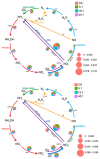Effects of Increasing the Nitrogen-Phosphorus Ratio on the Structure and Function of the Soil Microbial Community in the Yellow River Delta
- PMID: 39770622
- PMCID: PMC11677714
- DOI: 10.3390/microorganisms12122419
Effects of Increasing the Nitrogen-Phosphorus Ratio on the Structure and Function of the Soil Microbial Community in the Yellow River Delta
Abstract
Nitrogen (N) deposition from human activities leads to an imbalance in the N and phosphorus (P) ratios of natural ecosystems, which has a series of negative impacts on ecosystems. In this study, we used 16s rRNA sequencing technology to investigate the effect of the N-P supply ratio on the bulk soil (BS) and rhizosphere soil (RS) bacterial community of halophytes in coastal wetlands through manipulated field experiments. The response of soil bacterial communities to changing N and P ratios was influenced by plants. The N:P ratio increased the α-diversity of the RS bacterial community and changed the structure of the BS bacterial community. P addition may increase the threshold, causing decreased α-diversity of the bacterial community. The co-occurrence network of the RS community is more complex, but it is more fragile than that of BS. The co-occurrence network in BS has more modules and fewer network hubs. The increased N:P ratio can increase chemoheterotrophy and denitrification processes in the RS bacterial community, while the N:P ratio can decrease the N-fixing processes and increase the nitration processes. The response of the BS and the RS bacterial community to the N:P ratio differed, as influenced by soil organic carbon (SOC) content in terms of diversity, community composition, mutualistic networks, and functional composition. This study demonstrates that the effect of the N:P ratio on soil bacterial community is different for plant roots and emphasizes the role of plant roots in shaping soil bacterial community during environmental change.
Keywords: Yellow River Delta; bacterial community diversity; nitrogen and phosphorus input ratio; rhizosphere and bulk soil; salt marshes.
Conflict of interest statement
The authors declare no conflicts of interest.
Figures










Similar articles
-
Effects of short-term nitrogen and phosphorus addition on soil bacterial community of different halophytes.mSphere. 2024 May 29;9(5):e0022624. doi: 10.1128/msphere.00226-24. Epub 2024 Apr 29. mSphere. 2024. PMID: 38682927 Free PMC article.
-
Plants changed the response of bacterial community to the nitrogen and phosphorus addition ratio.Front Plant Sci. 2023 Mar 27;14:1168111. doi: 10.3389/fpls.2023.1168111. eCollection 2023. Front Plant Sci. 2023. PMID: 37051075 Free PMC article.
-
Diversity of Soil Microbial Communities in the Bulk and Rhizosphere Soils of Acanthopanax senticosus in Different Habitats.Curr Microbiol. 2025 Jan 6;82(2):73. doi: 10.1007/s00284-024-04054-4. Curr Microbiol. 2025. PMID: 39762585
-
Long-Term Nutrient Enrichment of an Oligotroph-Dominated Wetland Increases Bacterial Diversity in Bulk Soils and Plant Rhizospheres.mSphere. 2020 May 20;5(3):e00035-20. doi: 10.1128/mSphere.00035-20. mSphere. 2020. PMID: 32434837 Free PMC article.
-
Effects of nitrogen and phosphorus supply levels and ratios on soil microbial diversity-ecosystem multifunctionality relationships in a coastal nontidal wetland.Sci Total Environ. 2023 May 20;874:162472. doi: 10.1016/j.scitotenv.2023.162472. Epub 2023 Feb 25. Sci Total Environ. 2023. PMID: 36842587
References
-
- Zong N., Shi P.L. Differential responses of community structure and production. and the sensitivities of different alpine grasslands tonitrogen addition. Acta Ecol. Sin. 2020;40:4000–4010. doi: 10.5846/stxb201902250342. - DOI
-
- Hao J.H., Han H.K., Liu Y., Li J.H., Yang J.Y., Ren B.H., Bai L. Phosphorus addition alleviates the inhibition of nitrogen deposition on photosynthesis of Potentilla tanacetifolia. Front. Environ. Sci. 2023;11:3389. doi: 10.3389/fenvs.2023.1099203. - DOI
-
- Yu G., Jia Y., He N., Zhu J., Chen Z., Wang Q., Piao S., Liu X., He H., Guo X., et al. Stabilization of atmospheric nitrogen deposition in China over the past decade. Nat. Geosci. 2019;12:424–429. doi: 10.1038/s41561-019-0352-4. - DOI
LinkOut - more resources
Full Text Sources
Miscellaneous

